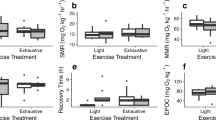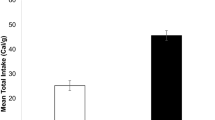Abstract
The influence of feeding on swimming performance and exercise recovery in fish is poorly understood. Examining swimming behavior and physiological status following periods of feeding and fasting is important because wild fish often face periods of starvation. In the current study, researchers force fed and fasted groups of largemouth bass (Micropterus salmoides) of similar sizes for a period of 16 days. Following this feeding and fasting period, fish were exercised for 60 s and monitored for swimming performance and physiological recovery. Resting metabolic rates were also determined. Fasted fish lost an average of 16 g (nearly 12%) of body mass, while force fed fish maintained body mass. Force fed fish swam 28% further and required nearly 14 s longer to tire during exercise. However, only some physiological conditions differed between feeding groups. Resting muscle glycogen concentrations was twofold greater in force fed fish, at rest and throughout recovery, although it decreased in both feeding treatments following exercise. Liver mass was nearly three times greater in force fed fish, and fasted fish had an average of 65% more cortisol throughout recovery. Similar recovery rates of most physiological responses were observed despite force fed fish having a metabolic rate 75% greater than fasted fish. Results are discussed as they relate to largemouth bass starvation in wild systems and how these physiological differences might be important in an evolutionary context.





Similar content being viewed by others
References
Adams SM, McLean RB, Parrotta JA (1982) Energy partitioning in largemouth bass under conditions of seasonally fluctuating prey availability. Trans Am Fish Soc 111:549–558
Alsop DH, Wood CM (1997) The interactive effects of feeding and exercise on oxygen consumption, swimming performance and protein usage in juvenile rainbow trout (Oncorhynchus mykiss). J Exp Biol 200:2337–2346
Bandeen J, Leatherland JF (1997) Transportation and handling stress of white suckers raised in cages. Aquac Int 5:358–396
Barton BA, Schreck CB, Fowler LG (1988) Fasting and diet content affect stress-induced changes in plasma glucose and cortisol in juvenile Chinook salmon. Prog Fish Cult 50:16–22
Barton BA, Morgan JD, Vijayan MM (2002) Physiological and condition-related indicators of environmental stress in fish. In: Adams SA (ed) Biological indicators of aquatic ecosystem stress. American Fisheries Society, Bethesda, pp 111–148
Bergmeyer HU (1965) Methods of enzymatic analysis. Academic Press, New York
Blasco J, Fernandez J, Gutierrez J (1992) Fasting and refeeding in carp. Cyprinus carpio L.: the mobilization of reserves and plasma metabolite and hormone variations. J Comp Physiol B 162:539–546
Booth C, Patel S, Bennion GR, Potten CS (1995) The isolation and culture of adult mouse colonic epithelium. Epithelial Cell Biol 4:76–86
Brown ML, Murphy BR (2004) Seasonal dynamics of direct and indirect condition indicies in relation to energy allocation in largemouth bass Micropterus salmoides. Ecol Fresh Fish 13:23–36
Carmichael GJ, Tomasso JR, Simco BA, Davis KB (1984) Confinement and water-quality induced stress in largemouth bass. Trans Am Fish Soc 113:767–777
Caruso G, Maricchiolo G, Micale V, Genovese L, Caruso R, Denaro MG (2008) Physiological responses to starvation in the European eel (Anguilla anguilla): effects on haematological, biochemical, non-specific immune parameters and skin structures. Fish Physiol Biochem. doi:10.1007/s10695-008-9290-6
Chan DKO, Woo NYS (1978) Effect of cortisol on the metabolism of the eel, Anguilla japonica. Gen Comp Endocrinol 35:205–215
Congleton JL, Wagner T (2006) Blood-chemistry indicators of nutritional status in juvenile salmonids. J Fish Biol 69:473–490
Davies R, Moyes CD (2007) Allometric scaling in centrarchid fish: origins of intra- and inter-specific variation in oxidative and glycolytic enzyme levels in muscle. J Exp Biol 210:3798–3804
Deng L, Zhang WM, Lin WM, Cheng CHK (2004) Effects of food deprivation on expression of growth hormone receptor and proximate composition in liver of black seabram Acanthopagrus schlegeli. Comp Biochem Physiol B 137:421–432
Druker EG (1996) The use of gait transition speed in comparative studies of fish locomotion. Am Zool 36:555–566
Garvey JE, Ostrand KG, Wahl DH (2004) Energetics, predation, and ration affect size-dependent growth and mortality of fish during winter. Ecology 85:2860–2871
Goede RW, Narton BA (1990) Organismic indices and an autopsy-based assessment as indicators of health and condition of fish. In: Adams SA (ed) Biological indicators of stress. American Fisheries Society, Bethesda, pp 93–108
Gonzalez RJ, McDonald DG (1992) The relationship between oxygen consumption and ion loss in a freshwater fish. J Exp Biol 163:317–332
Gustaveson AW, Wydowski RS, Wedemeyer GA (1991) Physiological response of largemouth bass to angling stress. Tran Am Fish Soc 120:629–636
Henderson IW, Garland HO (1980) General, comparative and clinical endocrinology of the adrenal cortex. Academic Press, London
Hinch SG, Collins NC (1991) Importance of diurnal and nocturnal nest defense in the energy budget of male smallmouth bass: insights from direct video observations. Trans Am Fish Soc 120:657–663
Houston AH (1990) Blood and circulation. In: Shreck CB, Moyle PB (eds) Methods for fish biology. American Fisheries Society, Bethesda, pp 237–334
Jentoft S, Aastveit AH, Torjesen PA, Andersen O (2005) Effects of stress on growth, cortisol and glucose levels in non-domesticated Eurasian perch (Perca fluviatilis) and domesticated rainbow trout (Oncorhynchus mykiss). Comp Biochem Physiol A 141:353–358
Kieffer JD (2000) Limits to exhaustive exercise in fish. Comp Biochem Physiol A 126:161–179
Keiffer JD, Tufts BL (1998) Effects of food deprivation on white muscle energy reserves in rainbow trout (Oncorhynchus mykiss): the relationships with body size and temperature. Fish Phys Biochem 19:239–245
Keiffer JD, Ferguson RA, Tompa JE, Tufts BL (1996) Relationship between body size and anaerobic metabolism in brook trout and largemouth bass. Trans Am Fish Soc 125:760–767
Kolok AS, Farrell AP (1994) Individual variation in the swimming peroformance and cardiac performance of Northern squawfish, Ptychocheilus oregonensis. Phys Zool 67:706–722
Lowry OH, Passonneau JV (1972) A flexible system of enzymatic analysis. Academic Press, New York
Mackereth RW, Noakes DLG, Ridgeway MS (1999) Size-based variation in somatic energy reserves and parental expenditure by male smallmouth bass, Micropterus dolomieu. Environ Biol Fish 56:263–275
McCarthy ID, Carter CG, Houlihan DF (1992) The effect of feeding hierarchy on individual variability in daily feeding of rainbow trout, Oncorhynchus mykiss (Walbaum). J Fish Biol 41:257–263
Mendez G, Wieser W (1993) Metabolic responses to food deprivation and refeeding in juveniles of Rutilus rutilus (Teleostei:Cyprinidae). Environ Biol Fish 36:73–81
Miranda LE, Hubbard WD (1994) Length-dependent winter survival and lipid composition of age -0 largemouth bass in Bay Springs Reservoir, Mississippi. Trans Am Fish Soc 123:80–87
Navarro I, Gutierrez J (1995) Fasting and starvation. In: Honchachka OW, Mommsen TP (eds) Biochemistry and molecular biology of fishes. Elsevier, Amsterdam, pp 393–434
Plaut I (2001) Crtical swimming speed: its ecological relevance. Comp Biochem Physiol A 131:41–50
Portz DE (2007) Fish-holding-associated stress in Sacramento River Chinook salmon (Oncorhynchus tshawytscha) at south delta fish salvage operations: effects on plasma constituents, swimming performance, and predator avoidance. Ph.D. thesis. University of California Davis, Davis, California, USA
Post JR, Parkinson EA (2001) Energy allocation strategy in young fish: allometry and survival. Ecology 82:1040–1051
Randall DJ, Baumgarten D, Malyusz M (1972) The relationship between gas and ion transfer across the gills of fishes. Comp Biochem Physiol A 41:629–637
Reidy SP, Nelson JA, Tang Y, Kerr SR (1995) Post-exercise metabolic rate in Atlantic Cod (Gadus morhua) and its dependence upon the method of exhaustion. J Fish Biol 47:377–386
Richards JG, Heigenhauser GJF, Wood CM (2002) Lipid oxidation fuels recovery from exhaustive exercise in white muscle of rainbow trout. Am J Physiol Regul Integr Comp Physiol 282:R89–R99
Rios FS, Kalinin AL, Rantin FT (2002) The effects of long-term food deprivation on respiration and haematology of the neotropical fish Hoplias malabaricus. J Fish Biol 61:85–95
Ruane NM, Huisman EA, Komen J (2002) The influence of feeding history on the acute stress response of common carp (Cyprinus carpio). Aquaculture 210:245–257
Sargent J, Henderson RG, Tocher DR (1989) The lipids. In: Halver JE (ed) Fish nutrition. Academic Press, New York, pp 154–218
Scarabello M, Wood CM, Heigenhauser GJF (1991) Glycogen depletion in juvenile rainbow trout as an experimental test of the oxygen debt hypothesis. Can J Zool 69:2562–2568
Schurmann H, Steffensen JF (1997) Effects of temperature, hypoxia and activity on the metabolism of juvenile Atlantic cod. J Fish Biol 50:1166–1180
Sheridan MA, Mommsen TP (1991) Effects of nutritional state on in vivo lipid and carbohydrate metabolism of coho salmon (Oncorhynchus kisutch). Gen Comp Endochrinol 81:473–483
Sherwood GD, Pazzia I, Moeser A, Hontela A, Rasmussen JB (2002) Shifting gears: enzymatic evidence for the energetic advantage of switching diet in wild-living fish. Can J Fish Aquat Sci 59:229–241
Steffensen JF (1989) Some errors in respirometry of aquatic breathers: how to avoid and correct for them. Fish Physiol Biochem 6:49–59
Sullivan KM, Somero GN (1983) Size and diet related variations in enzuymatic activity and tissue composition in the sablefish, Anoplopoma Fimbria. Biol Bull 164:315–326
Summerfelt RC, Smith LS (1990) Anesthesia, surgery and related techniques. In: Shreck CB, Moyle PB (eds) Methods for fish biology. American Fisheries Society, Bethesda, pp 213–272
Suski CD, Killen SS, Morrissey MB, Lund SG, Tufts BL (2003) Physiological changes in largemouth bass caused by live-release angling tournaments in southeastern Ontario. North Am J Fish Manage 23:760–769
Suski CD, Killen SS, Kieffer JD, Tufts BL (2006) The influence of environmental temperature and oxygen concentration on the recovery of largemouth bass from exercise: implications for live-release angling tournaments. J Fish Biol 68:120–136
Suski CD, Kieffer JD, Killen SS, Tufts BL (2007a) Sub-lethal ammonia toxicity in largemouth bass. Comp Biochem Physiol A 146:381–389
Suski CD, Cooke SJ, Tufts BL (2007b) Failure of low-velocity swimming to enhance recovery from exhaustive exercise in largemouth bass (Micropterus salmoides). Physiol Biochem Zool 80:78–87
Van der Boon J, Van den Thillart GEEJM, Addink ADF (1991) The effects of cortisol administration on intermediary metabolism in teleost fish. Comp Biochem Physiol A 100:47–53
Videler JJ (1993) Fish swimming. Chapman & Hall, London
Vijayan MM, Moon TW (1992) Acute handling stress alters hepatic glycogen metabolism in food deprived rainbow trout (Oncorhynchus mykiss). Can J Fish Aquat Sci 49:2260–2266
Watkins TB (1996) Predator-mediated selection on burst swimming performance in tadpoles of the Pacific tree frog, Pseudacris regilla. Physiol Zool 69:154–167
Wieser W, Krumschnabel G, Ojwang-Okwor JP (1992) The energetics of starvation and growth after refeeding in juveniles of three cyprinid species. Environ Biol Fish 33:63–71
Wood CM (1991) Acid-base and ion balance, metabolism, and their interactions, after exhaustive exercise in fish. J Exper Bio 160:285–308
Wood CM, Turner JD, Graham MS (1983) Why do fish dies after severe exercise? J Fish Biol 22:189–201
Wroblewski F, LaDue JS (1955) Lactic dehydrogenase activity in blood. Proc Soc Exp Biol Med 90:210–213
Yang TH, Somero GN (1993) Effects of feeding and food deprivation on oxygen consumption, muscle protein concentration. J Exp Biol 181:213–232
Zar JH (1999) Biostatistical analysis, 4th edn. Prentice-Hall, New Jersey
Acknowledgments
All of the experiments described in this study were conducted in accordance with the regulations and policies of the University of Illinois Office of Laboratory Animal Research. This project was supported by the United States Department of Agriculture Cooperative State Research Education and Extension Service by McIntire-Stennis funds through project ILLU-875-328, the Illinois Natural History Survey and the Illinois Department of Natural Resources. Illinois Natural History Survey staff, specifically Jimmy “Mac” McNamara and James “Jamie” Hopper, are thanked for their assistance with fish husbandry facilities.
Author information
Authors and Affiliations
Corresponding author
Additional information
Communicated by I. D. Hume.
Rights and permissions
About this article
Cite this article
Gingerich, A.J., Philipp, D.P. & Suski, C.D. Effects of nutritional status on metabolic rate, exercise and recovery in a freshwater fish. J Comp Physiol B 180, 371–384 (2010). https://doi.org/10.1007/s00360-009-0419-4
Received:
Revised:
Accepted:
Published:
Issue Date:
DOI: https://doi.org/10.1007/s00360-009-0419-4




